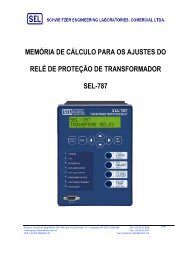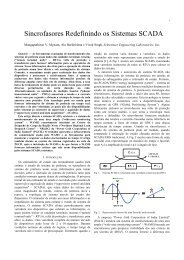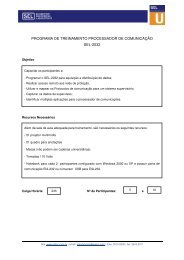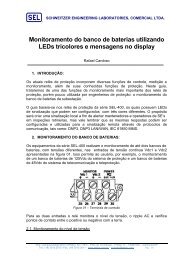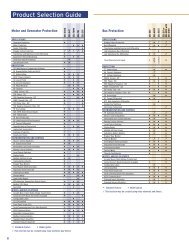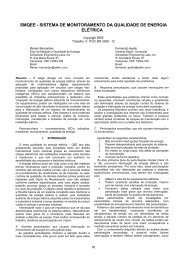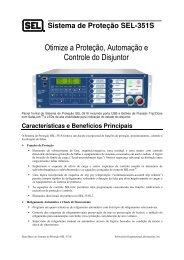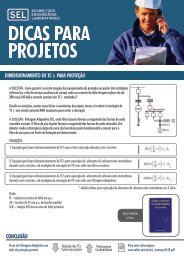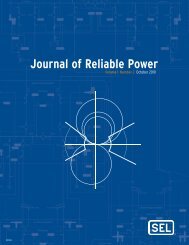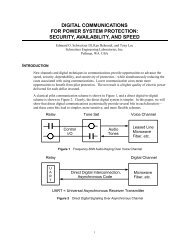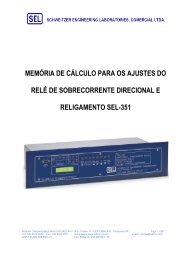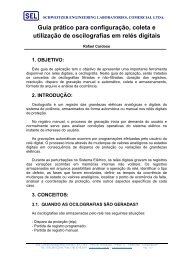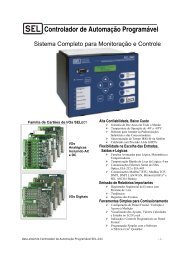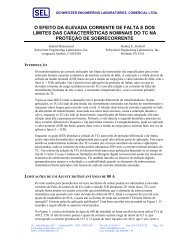Journal of Reliable Power - SEL
Journal of Reliable Power - SEL
Journal of Reliable Power - SEL
Create successful ePaper yourself
Turn your PDF publications into a flip-book with our unique Google optimized e-Paper software.
1<br />
Adaptive Phase and Ground<br />
Quadrilateral Distance Elements<br />
Fernando Calero, Armando Guzmán, and Gabriel Benmouyal, Schweitzer Engineering Laboratories, Inc.<br />
Abstract—Quadrilateral distance elements can provide<br />
significantly more fault resistance coverage than mho distance<br />
elements for short line applications. Quadrilateral phase and<br />
ground distance element characteristics result from the<br />
combination <strong>of</strong> several distance elements. Directional elements<br />
discriminate between forward and reverse faults, while reactance<br />
and resistance elements are fundamental to the proper<br />
performance <strong>of</strong> the quadrilateral characteristic. Load flow<br />
considerations determine the choice <strong>of</strong> the polarizing quantity for<br />
these elements. Reactance elements must accommodate load flow<br />
and adapt to it. Resistive blinders should detect as much fault<br />
resistance as possible without causing excessive overreach or<br />
underreach <strong>of</strong> the quadrilateral distance element. In this paper,<br />
we discuss an adaptive quadrilateral distance scheme that can<br />
detect greater fault resistance than a previous implementation.<br />
We also discuss application considerations for quadrilateral<br />
distance elements.<br />
Phase B are shown), the tower structure, the insulator chains,<br />
the ground wire, and the different impedances to the flow <strong>of</strong><br />
fault current. These impedances are simplified to be resistive<br />
values only [4][5].<br />
I. OVERVIEW<br />
Whereas the literature debates the differences and benefits<br />
<strong>of</strong> mho and quadrilateral ground distance elements [1], this<br />
paper describes the theory, application, and characteristics <strong>of</strong> a<br />
particular implementation <strong>of</strong> phase and ground quadrilateral<br />
distance elements.<br />
It is well accepted that a quadrilateral characteristic is<br />
beneficial when protecting short transmission lines [1][2]. It is<br />
also accepted that sensitive pilot protection schemes do not<br />
rely on distance elements only; these schemes also rely on<br />
ground directional overcurrent (67G), a unit that provides<br />
higher fault resistance (Rf) detecting capabilities than ground<br />
distance elements <strong>of</strong> any shape [3].<br />
Generally, high Rf faults have been associated with singleline-to-ground<br />
faults (AG, BG, CG). For these faults, the<br />
associated Rf is considerable. On the other hand, phase faults<br />
are less susceptible to high Rf values. However, because short<br />
transmission lines are much more affected by high Rf values,<br />
the element with the most fault detecting capabilities should<br />
be used [1][2][3].<br />
A. Fault Resistance<br />
Short circuits along the transmission line will have some<br />
degree <strong>of</strong> additional impedance. If this additional impedance<br />
is negligible, the line impedance is prevalent, and the apparent<br />
impedance measured will reflect it by reporting an impedance<br />
with the same angle as the line impedance. On the other hand,<br />
if this additional impedance is not negligible, the measured<br />
apparent impedance no longer appears at the line angle.<br />
Fig. 1 shows the different components <strong>of</strong> fault resistance<br />
for transmission line faults. Although extremely simplified,<br />
the figure shows the phase conductors (only Phase A and<br />
Fig. 1. Visualizing the Rf component<br />
The Rtower resistance is generally called the “footing<br />
resistance.” It is a critical parameter regarding the design and<br />
construction <strong>of</strong> transmission lines [6]. For an insulation<br />
flashover fault, the return path is through the tower itself.<br />
When a foreign object touches the conductors, the current<br />
distributes between adjacent towers but returns through the<br />
footing resistance. Ideally, the smaller the footing resistance,<br />
the better the transmission line ground fault detection<br />
performance will be. However, even though smaller values<br />
exist, practical values range from 5 to 20 ohms; and in rocky<br />
terrain, the resistance could be 100 ohms or more [1].<br />
In Fig. 1, Raφg represents the arc resistance for an insulator<br />
flashover for a phase-to-ground fault. This is in the path <strong>of</strong> the<br />
ground fault flashover current Igffo. Raφφ is the arc resistance<br />
for a phase-to-phase fault.<br />
The arc resistance value is dependent on the arc length and<br />
the current flowing through the arc. A well-accepted formula<br />
is the one empirically derived by A. Van Warrington,<br />
expressed in (1). Other equations yield similar results [7]. In<br />
(1), the arc length is expressed in meters.<br />
Rarc length<br />
= 28688.5 Ω (1)<br />
I 1.4<br />
The arc initially presents a few ohms <strong>of</strong> impedance. Over<br />
time, it could develop into 50 or more ohms [1]. Importantly,<br />
its value is dependent on the arc length and the current<br />
Adaptive Phase and Ground Quadrilateral Distance Elements | 65



